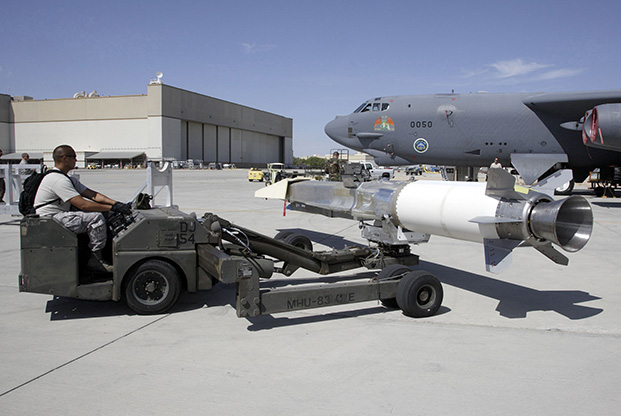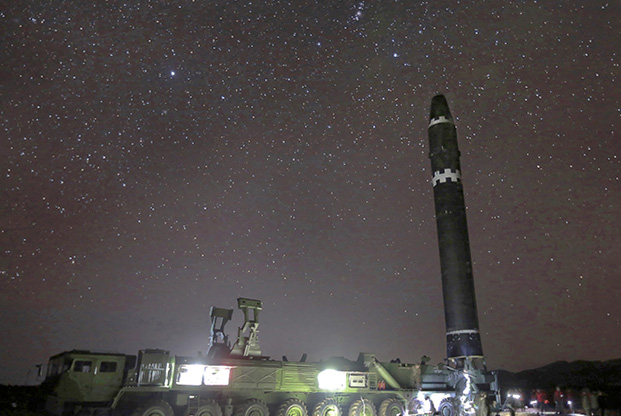
SSgt. Jonathan Young prepares to upload the X-51A WaveRider hypersonic flight test vehicle to a B-52 for fit testing at Edwards AFB, Calif. Photo: Chad Bellay/USAF
ISIS AFTER ISIS
The bomb-dropping phase to exterminate the so-called Islamic State may be over and its strongholds conquered, but ISIS is likely not going to be truly dead for years—and may never be—Gen. Paul A. Selva, Vice Chairman of the Joint Chiefs of Staff, explained in January.
Though many ISIS fighters were killed or captured, many escaped, likely to go back to their countries of origin still radicalized, Selva told defense journalists in Washington. One way to “thin the herd” is to get home countries to take back and imprison their citizens who fought for ISIS, or directed or committed domestic terrorism in places like Paris or Belgium. This approach can prevent, long-term, the “consolidation” of ISIS vets.
Coalition intelligence knows, though, that other “unaccounted for” survivors are attempting to return to their home countries, Selva said, and “what they’re going to do is hard to predict.” He’s worried that these radicalized fighters have gotten used to an environment where there are no “rules of engagement” and no restrictions on killing civilians or children.
They’re “very dangerous” he said, because the ISIS ideology pegged nonbelievers as not valuable. And their mindset is, “because you have no value, I may do with you as I please. I can take your life, I can rape you, I can subjugate you, I can do anything I want. And there’s no deprogramming involved in their return home, so that is a very, very compelling problem,” Selva explained. The kind of violence these fighters have unleashed on others is “unspeakable.”
_Read this story in our print issue:
The coalition is providing whatever information it can about returning ISIS fighters, but “the catalog” of foreign fighters is “not terribly precise.” Many have dual passports and multiple aliases, so home-country security may not even be aware of many individuals who fought for ISIS.
Unfortunately, “their ability to communicate … to their followers worldwide is still fairly robust,” Selva said. Social media and new encryption methods “make that possible.”
Worse, the videos and websites that radicalized ISIS recruits are still out there, and “the latency of stuff on the Internet is measured in years, not months or minutes,” Selva said. Hunting it all down and deleting it is a chore, because “people are willing to reinstall it” on other social media platforms. Selva warned that “the ideology of ISIS will persist for some time after the group itself is extinguished.”
Banning this material is “something we … as a free and open set of societies ought to be really thinking about,” he said. “How do we get at the counter-radicalization piece that will still have to go on after the physical caliphate itself is completely extinguished? Because we’re going to go about the process of rooting all this stuff out, off the Internet, and putting moderate voices out there that actually counter this ideology.”
And then, there will have to be economic opportunities made available “to the population that was the source of the foreign fighters in the first place.” Selva noted.: For example, those who “believe they’re disenfranchised all around the world, who are easy prey for that legacy of stuff that stays out there on the Internet.”
He added, “If we fail to address” those conditions, “my concern is, in five or 10 years, we’ll have ISIS 2.0 or al Qaeda 3.0, and the process will start again somewhere else in the world.”
Selva also said that it’s not the military’s task to address those underlying economic breeding grounds for terrorism.
“I kill people and break things. I don’t build schools and teach children the right way to treat one another. But somebody in government needs to be paying attention to that part,” he said.’ Lost Lead
In the area of hypersonics, Selva confirmed what current and former defense leaders have been saying for months: The US has lost its lead to China.
China, Selva said, has made hypersonics a “national program,” and has made plain that it’s willing to spend “up to hundreds of billions” of dollars “to solve the problems of hypersonic flight [and] hypersonic target designation.” While the US may have paved the way, China and Russia alike have “moved out pretty smartly” to conquer this field of technology.
The US, however, has not “lost the hypersonics fight,” Selva insisted. The US has “taken a different approach,” working on “a family of hypersonic systems that work without necessarily trying to close all the technology pieces” at the outset. The focus for the US is on making such a vehicle “survivable and maneuverable, which is a flight control problem.” Getting the vehicle to be responsive to commands and updates and hunting down moving targets is something that “will happen later in the development of the technology,” he revealed.
He did not say whether the preferred US approach is in a gliding vehicle, launched to hypersonic speed by a booster or an air-breathing approach like that taken in the X-51 program, but he clearly was referring to a hypersonic missile and not a manned platform.
“Can you scale hypersonics from a small, highly maneuverable, high-G, sturdy machine to something you’d put a human in? I’m not sure that one would invest the money to make that transition,” he said, suggesting a hypersonic weapon obviates the need for a hypersonic platform.
Selva declined to name a single hypersonics lead at the Pentagon, saying only that there are three entities working the problem. He would only name two. One is the Defense Advanced Research Projects Agency, or DARPA. “The Navy has a hypersonics program,” too, he said, and “the third one I won’t reveal,” he added.

A North Korean team elevates a missile for firing. Photo DPR Korea
GO FASTER!
In a January interview with Air Force Magazine, however, Air Force Vice Chief of Staff Gen. Stephen W. Wilson said “I can tell you we’re all doing things: us (the Air Force), DARPA, SCO (the Defense Department’s Strategic Capabilities Office),” and he allowed there’s “discussion in with the Department” about whether somebody should be in charge of the hyypresonic enterprise.
A possible candidate to be the Pentagon’s director for hypersonics might be the planned new Assistant Secretary of Defense for Research and Engineering, Wilson said, but that position “doesn’t exist yet.”
Wilson also said the Air Force can “never” again spend 20 years introducing a new system, because adversaries are simply developing new capabilities too rapidly.
“Speed wins,” Wilson asserted, explaining that he believes USAF’s new starts should have a goal of delivering combat capability within five years of a go-ahead. He pointed out that in the 1950s and 1960s, big programs were brought to the field within three years, but whether the nation can return to that model, “I don’t know.”
DOES NORTH KOREA HAVE THE GOODS
North Korea’s military has not yet openly demonstrated all the elements needed to make a successful nuclear-armed ICBM capable of reaching the continental US. In the January meeting with defense reporters, Selva said while Kim Jong Un has shown progress in long-range rockets and developing nuclear warheads, he has not demonstrated “all the components” of a true ICBM.
A fully functional ICBM is more than just a rocket and a warhead, Selva explained. The rocket has to be maneuvered such that it can “do the roll maneuver that actually points it in the direction of the United States.” Targeting and fuzing systems are also needed, and they must be packaged inside “a survivable re-entry vehicle that can withstand the stress and shock” of launch, transit, and re-entry when the unit is subjected to extreme heat and vibration.
To date, Kim has not demonstrated “the fusing and targeting technologies … or the re-entry vehicle,” Selva said. And while North Korea has conducted much of its rocket and nuclear research underground and in widely separated locations, Selva said he’s unaware of any way to test re-entry technologies underground.
“I believe we would be able to observe the tests” if they’d been made, Selva said. He also noted, however, that Kim has not pursued any part of its ICBM project in “the way we would do it. So it’s possible, although I think unlikely, he’s found a way to do the testing another way.” For that reason, the US must “place the bet that he might have” a working ICBM.
He admitted his concerns about North Korea developing a new class of vehicles which can very quickly raise and launch a missile. Pyongyang previously relied on Scud-type transporter-erector-launchers, or TELs, to move and launch missiles. Once they stop moving, they go through a process of raising and fueling the missile, requiring “tens of minutes to an hour,” Selva said, which allowed that much warning time of a launch if they were spotted.
Now, North Korea has new vehicles, mobile-erector-launchers or MELs.
These can move a missile out to a circular concrete launch pad, elevate it already fueled and launch in “a dozen minutes or so,” with a commensurate reduction in warning time.
Making the task doubly challenging is the fact that North Korea has been “very disciplined” about keeping its missile activities concealed when US satellites pass overhead, he said. It also practices good camouflage techniques and keeps as much illicit activity as it can underground, Selva noted, adding “it’s very hard to catch them out in the open.”
Selva insisted the US does not “do preemption,” but wouldn’t simply wait to be attacked if it saw troubling activity. Any action would have to be taken within the context of rhetoric and provocations signaling that North Korea was getting ready to launch. But if the context signaled that intent—and the US could not necessarily see all of North Korea’s missiles—it could still render them ineffective by attacking their supporting infrastructure, such as crews, fuel, command and control, etc.
In certain circumstances, all of those things would become “legitimate, proportional, discriminate military targets,” Selva asserted. If “the poor sergeant” whose job it is to launch the missile is bombed in his quarters, he’s “not available” to perform that task, Selva pointed out.
Though a “bolt out of the blue” attack with no warning or provocative precursors is always possible, Selva said it’s unlikely, and if tensions rose, the US could adjust its “day-to-day posture” in the region to have assets in place capable of crippling North Korea’s missile capability.
If North Korea succeeded in launching a missile, the US has space-based means of detecting it and ground-based means of tracking and intercepting it, Selva noted.